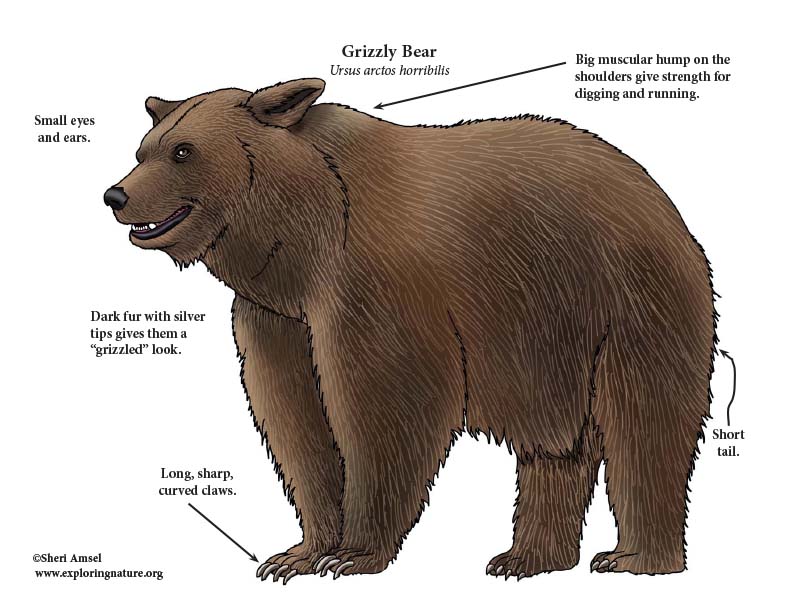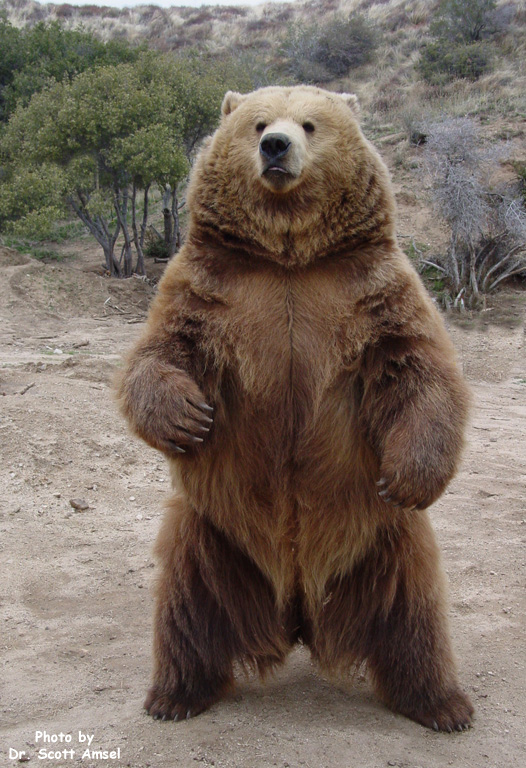

Grizzly bears are found in the Northwestern U.S. (Wyoming, Montana, Idaho, and Washington), Canada and Alaska. Grizzlies are a smaller group – a subspecies – of brown bears. Another subspecies is the Kodiak bear. Kodiak bears are from the Islands off the coast of Alaska. These bears are even bigger than grizzly bears.
Grizzlies live in open areas (not thick forest) up in the mountains. They like wild forest habitats. They would rather not be near where people live and work. There may be less than 1,000 grizzly bears left in the lower 48 states. Scientists think that there used to be many more grizzlies in the United States. In the 1900s settlers moved into the west. Before then, there may have been as many as 100,000 grizzly bears in North America.
Grizzlies are one of the largest mammals in North America. Only the polar bear is larger. Full-grown male grizzlies can reach more than 1,000 pounds. Though most grizzlies are smaller than that. When a big male grizzly bear stands on its back legs, it can be 8-feet-tall. Females are smaller than males. They weigh from 300-700 pounds. Sometimes males can be twice the size of females.
Grizzly bears can be many colors. They can be white, tan, brown and black. The tips of their fur are often lighter in color. This gives them a “grizzled” look. That is why they are called grizzlies! They have large faces, with short, rounded ears. They have thick humps on their shoulders made of muscle. This gives them great strength in their front legs. They also have long, curved claws for digging. This is important when digging out a den for winter. Their front feet leave big, 8-inch long, 9-inch wide tracks. Their back feet leave 16-inch long, 10-inch wide tracks.
Grizzlies normally feed in the mornings and evenings. By late summer, they are so hungry they eat all the time. They have to gain weight before they den up for winter. Then they will to sleep (hibernate) for many months. They will not eat or drink again until spring. Their body temperature drops and heart beat slows. They lose much of the body weight they gained eating all year. A bears’ winter sleep is not considered “true hibernation.” Scientists call it “torpor.”
To make a den, grizzlies use their long, sharp claws. They choose the right spot for a den. They dig under a fallen tree. They dig under a large rock. They dig into the side of a slope. The winter snow will cover their den. It will help keep them warm through the coldest times.
Grizzlies usually live alone. They are only with other bears at certain times. Males and females come together to mate. A mother bear lives with her cubs for about three and half years. Sometimes if there is a lot of food in one place, many bears will feed together until it’s gone. A river full of fish is a lot of food. A ripe berry patch is a lot of food. Even a garbage dump is a lot of food to a bear.
A grizzly can run up to 35 miles per hour.
Grizzlies eat a wide variety of food. They are omnivores and eat roots, bulbs, nuts, seeds, berries, insects, fish, dead animals (carrion) and small mammals. They have a great sense of smell. They can sniff out and steal piles of nuts buried by squirrels. They can also smell a dead animal (carrion) from miles away! Grizzly bears can also kill moose, elk, mountain goats and big horned sheep.
Grizzlies eat what they can find. In different places, they find different foods. In Yellowstone, grizzlies like to eat the seeds of the Whitebark pine cone. They also like army cutworm moths. They are found high up in the mountains and are full of fat. The bears will eat thousands of them. It helps them gain weight for their winter sleep. There are also many elk in Yellowstone. So these bears will eat more meat. In Alaska they find salmon to eat. In the mountains, they find berries and insects to eat.
The only predator that kills grizzlies is man, though one grizzly may kill another.
Grizzlies are not really full grown until they are more than 10-years-old. They can start to have young after they reach about 5-years-old. Grizzlies mate in the spring right after they wake from hibernation. If a female is healthy and fat enough, she will have her babies in the den between January and March the following winter. Grizzlies only have young every three to five years. They usually have two cubs, but sometimes just have one. Rarely, they have three cubs.
They live up to 30 years in the wild. Captive grizzly bears can live more than 40 years.
They are threatened in some populations – like the Yellowstone Park grizzlies. They are stable, however, in their Alaskan populations.
Kingdom: Animalia
Phylum: Chordata
Subphylum: Vertebrata
Class: Mammalia
Order: Carnivora
Suborder: Caniformia
Family: Ursidae
Genus: Ursus
Species: Ursus arctos horribilis
When you research information you must cite the reference. Citing for websites is different from citing from books, magazines and periodicals. The style of citing shown here is from the MLA Style Citations (Modern Language Association).
When citing a WEBSITE the general format is as follows.
Author Last Name, First Name(s). "Title: Subtitle of Part of Web Page, if appropriate." Title: Subtitle: Section of Page if appropriate. Sponsoring/Publishing Agency, If Given. Additional significant descriptive information. Date of Electronic Publication or other Date, such as Last Updated. Day Month Year of access < URL >.
Amsel, Sheri. "Bear (Grizzly)" Exploring Nature Educational Resource ©2005-2024. December 13, 2024
< http://exploringnature.org/db/view/313 >


